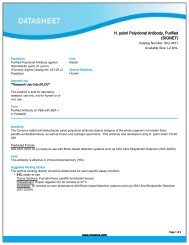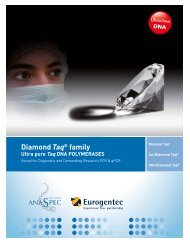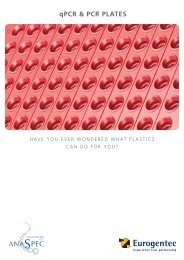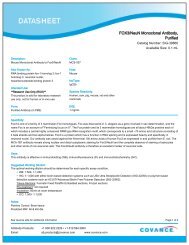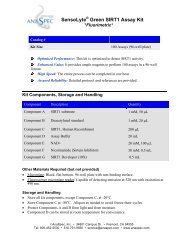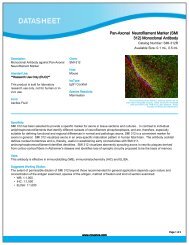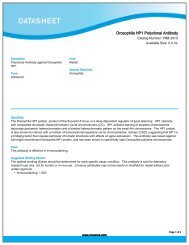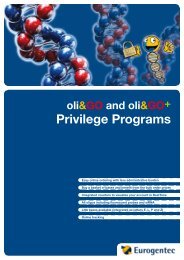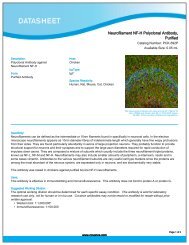0739 v1.2 Duolink Brochure - final - Eurogentec
0739 v1.2 Duolink Brochure - final - Eurogentec
0739 v1.2 Duolink Brochure - final - Eurogentec
You also want an ePaper? Increase the reach of your titles
YUMPU automatically turns print PDFs into web optimized ePapers that Google loves.
Discover more about proteins and protein interactions
Introduction<br />
The <strong>Duolink</strong> ® approach provides new insights into proteins and protein interactions.<br />
For the first time, individual proteins, their interactions and modifications, can be<br />
accurately and objectively quantified in unmodified cells and tissues. Utilizing only a few<br />
cells, sub-cellular events, even transient or weak interactions, are revealed in situ and<br />
sub-populations of cells can be differentiated. Within hours, results from conventional<br />
co-immunoprecipitation and co-localization techniques can be confirmed.<br />
<strong>Duolink</strong> – Protein interactions<br />
3
Visualize and locate protein interactions<br />
The <strong>Duolink</strong> kits are based on in situ PLA ® , a technology that extends the capabilities of traditional<br />
immunoassays to include direct detection of protein interactions with unparalleled specificity and<br />
sensitivity. For the first time, any target can be readily detected and localized with single molecule<br />
resolution. The following pages illustrate the advantages of utilizing this approach.<br />
1. SIMULTANEOUSLY VISUALIZE AND LOCATE PROTEIN-PROTEIN INTERACTIONS<br />
A <strong>Duolink</strong> kit reveals individual proteins and their interactions as quantifiable fluorescent signals or<br />
chromogenic stains. Each kit can be configured to meet specific assay requirements.<br />
2. SEE SUB-CELLULAR EVENTS IN SITU<br />
Retain protein localization. No modification of cells or tissue. No cell lysis, no over-expression,<br />
no interference from tags.<br />
4 <strong>Duolink</strong> – Protein interactions<br />
Fig 1. Single event resolution. Each red spot<br />
represents an SMAD 1/2/3 and SMAD 4<br />
interaction in mouse embryonic fibroblasts.<br />
Green: FITC-anti-actin.<br />
Blue: DAPI stained nuclei.<br />
Fig 2. Breast cancer tissue (<strong>Duolink</strong><br />
Detection Reagents Brightfield).<br />
Brown: HER2/HER3 interactions.
3. REVEAL TRANSIENT AND WEAK INTERACTIONS IN SITU<br />
Detection and quantification of VE-PTP/VEGFR2 complexes in situ in endothelial cells treated or not<br />
with ligand (VEGF) for different time periods.<br />
0 min – Unstimulated<br />
10 min – Stimulated<br />
5 min – Stimulated<br />
15 min – Stimulated<br />
Fig 3. Red: VE-PTP/VEGFR2 complexes.<br />
Blue: Hoechst stained nuclei.<br />
Reproduced through the courtesy of FASEB<br />
Journal. Ref: Mellberg et al. FASEB J. 2009<br />
May;23(5):1490-1502.<br />
QUANTITATIVE ANALYSIS<br />
Fig 4. Quantification of VE-PTP/VEGFR2<br />
complexes.<br />
“… we were able to confirm data from a<br />
2-hybrid screen and from co-immunoprecipitation<br />
experiments that demonstrated a dynamic<br />
interaction between a membrane receptor and a<br />
transcription factor.”<br />
Spots per cell<br />
100<br />
80<br />
60<br />
40<br />
20<br />
0<br />
0 2 5 10 15<br />
VEGF min<br />
Roxana Pincheira, PhD,<br />
University of California San Francisco<br />
<strong>Duolink</strong> – Protein interactions<br />
5
4. STUDY HOMODIMERIC PROTEIN COMPLEXES<br />
<strong>Duolink</strong> Probemaker enables the study of homodimeric complexes by allowing the use of same species<br />
monoclonal antibodies. Simply include Probemaker probes, instead of PLA probes, in a <strong>Duolink</strong> kit.<br />
Normal tissue Cancerous tissue<br />
5. WORK WITH ENDOGENOUS PROTEINS USING ONLY A FEW CELLS<br />
ER alpha/DYX1C1 interaction visualized in cell’s neurite extensions. Rat embryonic hippocampal neurons<br />
cultured 48 hours with estradiol. Proteins detected at endogenous levels – not seen using Western blot.<br />
Unstimulated control<br />
6 <strong>Duolink</strong> – Protein interactions<br />
Estradiol-stimulated<br />
Fig 5. Visualization of HER2/HER2<br />
homodimers in breast tissue.<br />
Red:HER2/HER2 homodimers.<br />
Blue: DAPI stained nuclei.<br />
Fig 6. Red: ER alpha/DYX1C1 interactions.<br />
Blue: Hoechst stained nuclei.<br />
Green: FITC-anti-actin.<br />
Reproduced through the courtesy of Human<br />
Molecular Genetics. Ref: Massinen et al. Hum<br />
Mol Genet. 2009 May 7.<br />
“… an important tool … for visualization of novel<br />
protein-protein interactions in cell lines and primary<br />
cells from different species.”<br />
Hans Matsson, PhD,<br />
Dept. of Biosciences and Nutrition,<br />
Karolinska Institute, Sweden
6. DIFFERENTIATE BETWEEN SUB-POPULATIONS OF CELLS<br />
Evaluate phosphorylation levels. Discrete fluorescent signals reveal phosphorylation of PDGF<br />
receptors.<br />
Unstimulated control<br />
PLA SIGNALS (SIGNALS/CELL)<br />
50<br />
45<br />
40<br />
35<br />
30<br />
25<br />
20<br />
15<br />
10<br />
5<br />
0<br />
NON STIMULATED STIMULATED<br />
Fig 8. Dedicated <strong>Duolink</strong> ImageTool<br />
generates accurate data.<br />
BB (PDGF ligand)-stimulated cells<br />
Fig 7. Red: phosphorylated PDGF<br />
receptors.<br />
Blue: Hoechst stained nuclei.<br />
“… allows visualization of the cellular<br />
compartment (nucleus, cytoplasm, etc) in which<br />
protein-protein interactions take place.“<br />
Mark Wade, PhD,<br />
Gene Expression Laboratory (Wahl Lab),<br />
The Salk Institute, San Diego, USA<br />
<strong>Duolink</strong> – Protein interactions<br />
7
7. SEE SUB-POPULATIONS OF CELLS WITHIN TISSUE SAMPLES<br />
Analysis of PDGF receptor in paraffin-embedded choroid plexus carcinoma tissue reveals<br />
phosphorylated PDGF α and β receptor complexes in situ.<br />
α receptor β receptor<br />
8. CONFIRM CONVENTIONAL CO-IP AND CO-LOCALIZATION RESULTS – IN ONE STEP<br />
Detection of PDGF-Rβ/VEGF-R2 receptor interactions after growth factor treatments of cells.<br />
8 <strong>Duolink</strong> – Protein interactions<br />
Fig 10. Red: PDGF-Rβ/VEGF-R2 receptor<br />
interactions. Blue: Hoechst stained<br />
nuclei. Green: Cytoplasm stained with<br />
Alexa 488-Phalloidin.<br />
Reproduced through the courtesy of Nature.<br />
Ref: Greenberg et al. Nature 2008 Nov 9.<br />
Fig 9. Red: PDGFR α or β.<br />
Blue: Hoechst stained nuclei.<br />
Green: autofluorescence.<br />
Reproduced through the courtesy of Janna<br />
Paulsson, PhD. Dept. of Oncology-Pathology<br />
Karolinska Institute. Ref: Koos B, et al. Am. J.<br />
Pathol. 2009, 175:1631-163.<br />
“… may ultimately prove to be equivalent to<br />
FRET, but with the significant benefit of detecting<br />
endogenous protein-protein interactions.“<br />
David A. Cheresh, Ph.D.,<br />
Professor and Vice Chair of Pathology,<br />
University of California, San Diego,<br />
Moores Cancer Center
9. ACCURATELY QUANTIFY EXPRESSION LEVELS<br />
Discrete fluorescent signals reveal expression of EGF receptor in A431 cells.<br />
Primary antibody against EGFR<br />
HIGH SIGNAL TO NOISE<br />
1000<br />
100<br />
10<br />
1<br />
Immunofluorescence<br />
<strong>Duolink</strong><br />
Negative control,<br />
no primary antibody added<br />
Fig 12. PLA signal-to-noise<br />
ratio 100 times higher than<br />
immunofluorescence (data derived<br />
from comparison with controls - no<br />
primary antibody added).<br />
Fig 11. Red: EGF receptors.<br />
Blue: DAPI stained nuclei.<br />
“… a state of the art quantitative protein<br />
technology that has furthered our research on<br />
human brain tumors above and beyond classical<br />
protein techniques.“<br />
Markus Bredel, MD, PhD,<br />
Northwestern University, Chicago<br />
<strong>Duolink</strong> – Protein interactions<br />
9
Results within one day<br />
PREPARATION<br />
PREPARATION AND INCUBATION OF PRIMARY ANTIBODIES AND PLA PROBES.<br />
STEP 1.<br />
Fix cells or tissues onto microscope<br />
slide, add blocking solution.<br />
Typical starting materials are adherent<br />
cells, cytospin preparations or tissue<br />
sections on a glass slide, fixed, pretreated<br />
and blocked with a blocking<br />
reagent according to the requirements<br />
of the primary antibodies used.<br />
DETECTION<br />
AMPLIFICATION AND DETECTION OF BOUND PLA PROBES.<br />
STEP 4.<br />
Wash and add Ligation solution.<br />
The Ligation solution, consisting of<br />
two oligonucleotides (illustrated as red<br />
bands) and Ligase, is added and the<br />
oligonucleotides will hybridize to the two<br />
PLA probes and join to a closed circle if<br />
they are in close proximity (
ANALYSIS<br />
IMAGING AND QUANTITATIVE ANALYSIS.<br />
STEP 7.<br />
Review and capture images.<br />
The PLA signal is recognized as a<br />
fluorescent or chromogenic spot. For<br />
fluorescent microscopy, use the appropriate<br />
filters for the detection fluorophore used.<br />
Export raw data into <strong>Duolink</strong> ImageTool for<br />
objective quantification.<br />
ADDITIONAL APPLICATIONS<br />
Using the in situ PLA technology you can also detect modifications such as phosphorylations or the<br />
expression of a single protein.<br />
DETECT AND QUANTIFY<br />
PROTEIN PHOSPHORYLATION<br />
Detection of a modified protein such<br />
as a phosphorylated receptor can<br />
be done using one primary antibody<br />
against the receptor and the other<br />
against the phosphorylated site.<br />
STEP 8.<br />
Obtain objective quantification using<br />
<strong>Duolink</strong> ImageTool.<br />
Automatic detection of nuclei and<br />
cytoplasmic regions. Compatible with data<br />
formats from major microscope vendors<br />
including Olympus, Leica, Nikon and<br />
Zeiss. Data can be exported into Excel for<br />
further evaluation.<br />
DETECT AND QUANTIFY<br />
PROTEIN EXPRESSION<br />
Detection of a single protein with<br />
high sensitivity can be done using<br />
only one primary antibody. Use PLA<br />
probes PLUS and MINUS against<br />
the same species.<br />
STEP 9.<br />
Data analysis.<br />
50<br />
45<br />
40<br />
35<br />
30<br />
25<br />
20<br />
15<br />
10<br />
5<br />
0<br />
NON STIMULATED STIMULATED<br />
<strong>Duolink</strong> ImageTool enables single cell<br />
statistical analysis of expression levels in<br />
tissue or cell populations.<br />
DETECT AND QUANTIFY<br />
PROTEIN EXPRESSION<br />
Detection of a single protein with<br />
high sensitivity and specificity.<br />
Use two primary antibodies from<br />
different species against different<br />
epitopes of the same protein.<br />
<strong>Duolink</strong> – Protein interactions<br />
11
The <strong>Duolink</strong> solution<br />
BUILD YOUR OWN KIT<br />
Each <strong>Duolink</strong> in situ PLA protein detection kit consists of customizable kit components and can be<br />
configured to meet specific assay requirements. In addition to the kit components you will also need<br />
two primary antibodies raised in different species.<br />
BUILDING A KIT THAT PERFECTLY MATCHES YOUR NEED IS EASILY DONE<br />
IN FOUR STEPS<br />
1. Choose PLA probe PLUS against the species one of your primary antibody has been raised in or Probemaker PLUS<br />
2. Choose PLA probe MINUS against the species the other primary antibody has been raised in or Probemaker MINUS<br />
3. Choose detection reagents depending on your mode of detection, fluorescence or chromogenic<br />
4. Choose the optimal accessories for your <strong>Duolink</strong> application<br />
All necessary diluent solutions, enzymes and reagents needed to perform the <strong>Duolink</strong> assay are included in the kit components<br />
together with detailed step-by-step instructions.<br />
12 <strong>Duolink</strong> – Protein interactions
CUSTOMIZABLE KIT COMPONENTS<br />
PLA probe PLUS; anti-Mouse PLUS, anti-Goat PLUS or anti-Rabbit PLUS<br />
PLA probe MINUS; anti-Mouse MINUS, anti-Goat MINUS or anti-Rabbit MINUS<br />
Probemaker PLUS and MINUS enables you to ”make your own” PLA probes by<br />
conjugating the PLA oligonucleotide arms directly to antibodies<br />
Detection Reagents; Orange, Red, Far red or Green for fluorescence microscopy<br />
Detection Reagents Brightfield for brightfield microscopy<br />
RECOMMENDED ACCESSORIES<br />
Wash Buffers for fluorescence or brightfield – ready-to-use powder for all<br />
wash buffers<br />
Control Kit – reference slides, primary antibody and PLA probes to use as<br />
positive controls with fluorescence-based assays<br />
Mounting Medium with or without DAPI nuclear stain to preserve<br />
fluorescence signals<br />
Brightfield Mounting Medium for chromogenic-based assays<br />
<strong>Duolink</strong> Image Tool for image evaluation and result quantification<br />
<strong>Duolink</strong> – Protein interactions<br />
13
How to order<br />
For information about the <strong>Duolink</strong> products visit www.olink.com. We strongly recommend that you<br />
use the <strong>Duolink</strong> Kit Wizard, which configures the kit to suit your needs. Orders can be placed directly<br />
online or sent via email to order@olink.com.<br />
Online purchasing is available in selected countries. For information about your local distributor visit<br />
www.olink.com/contact/distributors.<br />
14 <strong>Duolink</strong> – Protein interactions
Olink Bioscience is based on a strong intellectual property portfolio focused towards the development<br />
of cutting edge technologies for biomolecular analysis in research and diagnostics. The company’s<br />
proprietary <strong>Duolink</strong> product line enables researchers in academia and the pharmaceutical industry to<br />
visualize and accurately quantify individual proteins, their interactions and modifications, in unmodified<br />
cells and tissues. Such information is crucial to help elucidate disease mechanisms, leading to the<br />
development of novel diagnostics and therapeutics. The <strong>Duolink</strong> line is marketed and sold through a growing<br />
distributor network. A second revenue stream comes from the out-licensing of other proprietary technologies<br />
to major biotech supply companies.<br />
Olink Bioscience is a privately held company, founded in 2004, and headquartered in Uppsala, Sweden.<br />
© 2010 Olink AB. <strong>Duolink</strong> and PLA are trademarks of Olink AB.<br />
All third party trademarks are the property of their respective owners.<br />
Olink Bioscience, Dag Hammarskjölds v. 54A<br />
SE-751 83 Uppsala, Sweden<br />
www.olink.com<br />
<strong>0739</strong>, v. 1.2, 2010-11-11



